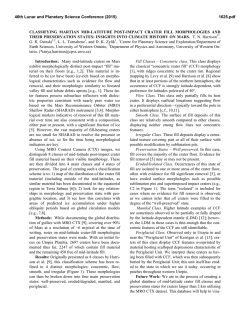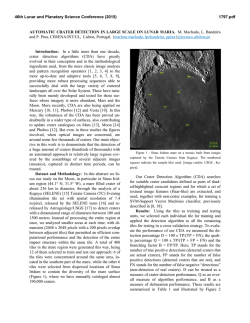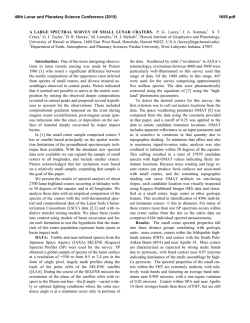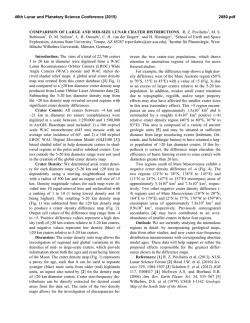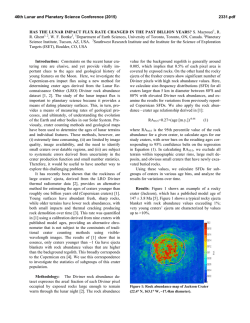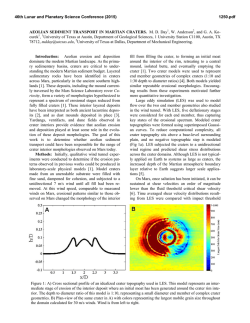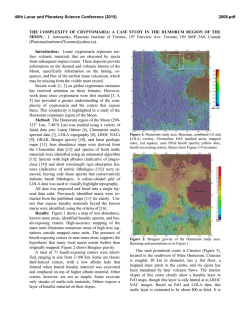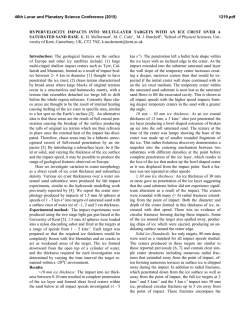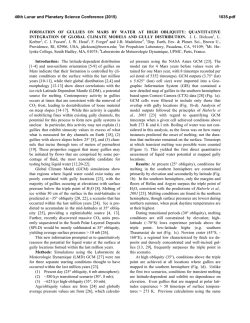
glacial environment between the interval of concentric crater fill and
46th Lunar and Planetary Science Conference (2015) 1774.pdf GLACIAL ENVIRONMENT BETWEEN THE INTERVAL OF CONCENTRIC CRATER FILL AND GULLY FORMATION ON MARS: INSIGHTS FROM LOBATE FLOW FEATURES IN ALBA PATERA CRATERS. Vijayan S., Rishitosh K. Sinha and S.V.S. Murty, PLANEX, Physical Research Laboratory, Ahmedabad 380009, India. ([email protected]) Introduction: Glacial features have been well recognized on Mars, and their modes of formation have been analyzed at several scales to interpret the relationships between their ages and extents of ice accumulation and glacial action [1-6]. The formation of lobate debris apron (LDA)/lineated valley fill (LVF) during past ~100 Ma-1 Ga correspond to period of major glaciation [2], followed by a relatively moderate glacial episode (~60-300 Ma) that resulted in the formation of concentric crater fill (CCF) [3], which was subsequently followed by a period of minor glaciation (<10 Ma) that has initiated gully activity [6]. Additional evidences have been presented to account for several intermediate processes that resulted in the formation of viscous flow features (VFF) (~0.1-30 Ma) [4], lobate debris tongues (LDT) (>8 Ma) [7], thermal contraction crack polygons (TCP) (<5 Ma) [5] etc. Although the cluster of glacial features have been broadly recognized, one of the glacial landforms have not been analyzed and well characterized globally and/or regionally despite their significance for understanding the evolution of the martian climate. A major outstanding question that still remains to be well understood is nature of glacial envi- ronment existing between the periods that led to formation of CCF and gullies, i.e. between ~60-10 Ma. In an effort to address this question, we report on the identification of a landform displaying flow characteristics similar to lobate flow features (LFF) within craters lying in Alba Patera region of Mars (Fig. 1) [8]. We present additional evidence for young, less moderate glaciation in the study region by examining the geomorphological characteristics of LFFs spread over the floor of craters adjacent to the pole-facing wall (PFW) and determining their best-fit age. Morphological description and age of LFF: Inspection of crater floor morphology from study region revealed presence of radial LFFs extending away from the base of PFW of these craters towards the center of floor. Most of the craters in the region display such LFFs that facilitated flattening and/or smoothening of their pole-facing slopes. The area occupied by LFFs of the craters floor suggested that the depositional process involved ice/snow excess of that required for forming gullies, but less than that involved in CCF emplacement, as indicated by it’s radial/unidirectional flow. The radial flow of ice/snow-rich material seems to have Fig. 1. Contextual map of study region indicating the locations of LFF bearing craters within Alba Patera 46th Lunar and Planetary Science Conference (2015) draped over the crater wall and deposited the eroded mass at the floor in the form of large heaps. The surface of these heaps displayed typical longitudinal features and moraine-like ridges consistent with the nature of landforms expected in terrestrial glacial systems. We could identify multiple small craters over the surface of LFFs that are indicative of their relatively older formation age in comparison to the younger features (TCPs, gullies, and arcuate ridges) formed in the vicinity. Overall, our crater size frequency distribution results indicate that LFFs formed in an intermediate period between CCF and gullies (i.e. within ~60-10 Ma) that faced the significant change in accumulation extent and flow of glacial ice in the history of Late Amazonian Mars (Fig. 2) [9]. Correlation with orientation constraints: Based on the latest crater data, it has been reported that cold, pole-facing slopes of craters lying within low-latitudes (<40˚-45˚) in each hemisphere marked the preferable site for accumulation of ice/snow during the past [10]. In all the craters lying within this latitudinal band where we observed readily perceptible view of LFFs, their presence was noted to be linked to its PFW; on the equator-facing slopes, we could not observe any similar characteristics. The presence of such intermediate LFFs in the vicinity of PFWs support the idea that the period prior to gully formation accumulated excess ice/snow over the same pole-facing slopes over which gullies preferred to form later in the recent glacial epochs with relatively less accumulation extents [6]. In addition, many of such LFF bearing craters displayed presence of TCP, gullies and arcuate ridges, respectively, on their pole-facing slopes. The co-existing presence of both these younger (gullies, TCPs etc) and relatively older LFFs over the PFWs suggest that the formation of both these class of features was dependent on the atmospheric accumulation of ice/snow during the past higher obliquity excursions and ice/snow consistently accumulated at the same pole-facing slopes for a much larger period (~60-0.4 Ma) than noted earlier. Implications of LFF in understanding evolution of martian climate: The interpretation of large scale LDA/LVF in the mid-latitudes and their wide range of formation ages (~100 Ma-1 Ga) suggested that the climatic conditions during the period of higher obliquity excursions (≥ 45˚) favored elevated extents of ice/snow to accumulate and sublimate for a geologically longer history. The next level of climate change was noticed during the period (~60-300 Ma) when the amount of ice/snow accumulating within craters reduced to a quantity that could inititate formation of CCFs. The last phase was more dramatic wherein the ice/snow trapped within alcoves could undergo melting sufficient enough to produce long, linear channels over the pole-facing 1774.pdf Fig. 2. Best-fit age plot obtained for craters C1-C6 by counting the craters over the surfaces of LFF slopes of craters during the recent glacial episodes (within 10 Ma). The addition of LFFs into this unexplored time gap, i.e. between CCF and gully formation periods (~60-10 Ma), suggests that prior to the period of melting of the minor amount of ice/snow trapped within alcoves, the accumulated ice/snow mass has undergone sublimation from the PFWs of craters. Such a period of climate change has been characterised with an environment that has reduced the extents of ice/snow accumulating to all the faces of crater wall, except to its pole-facing slopes. This ~50 Ma of LFF supporting climate recently changed to a phase in which the accumulation extents of ice/snow significantly reduced, confining to the small alcoves and supporting short duration melting at certain locations and periods in the recent past (<10 Ma). In the current state of Martian climate (obliquity ~25˚), the wind blown ice/snow and seasonal CO2 ice trapped into alcoves could only undergo minor sublimation, as the critically low P-T conditions do not permit any possibilities for their melting. References: [1] Sinha R.K. and Murty S.V.S. (2013a) PSS, 86, 10-32. [2] Baker D.M.H. et al. (2010) Icarus, 207, 186-209. [3] Levy J. et al. (2010) Icarus, 209, 390-404. [4] Milliken R.E. et al. (2003) JGR, 108(E6), 5057. [5] Levy J. et al. (2009) JGR, 114, E01007. [6] Dickson J.L. and Head J.W. (2009) Icarus, 204, 63-86. [7] Morgan G.A. et al. (2011) Icarus, 211, 347-365. [8] Sinha R.K. and Murty S.V.S. (2013b) JGR, 118, 1609-1631. [9] Hartmann W.K. (2005) Icarus, 174, 294-320. [10] Dickson J.L. et al. (2012) Icarus, 219, 723-732.
© Copyright 2026

